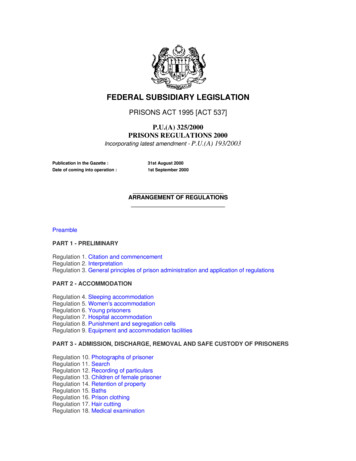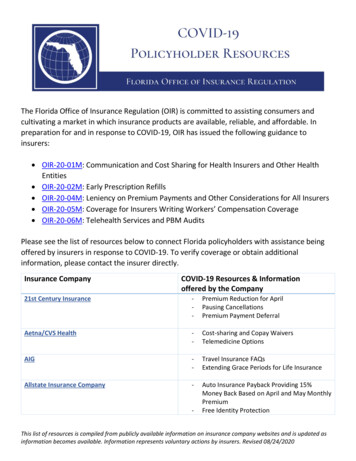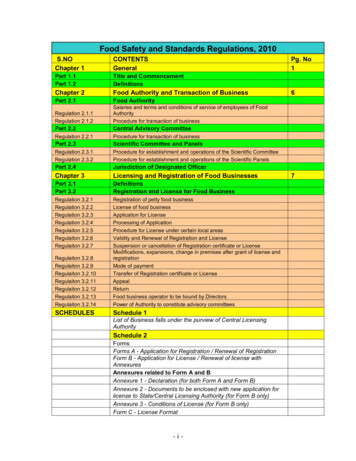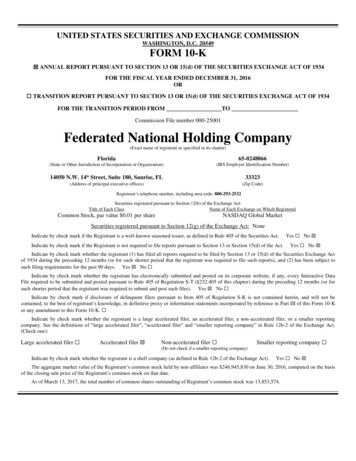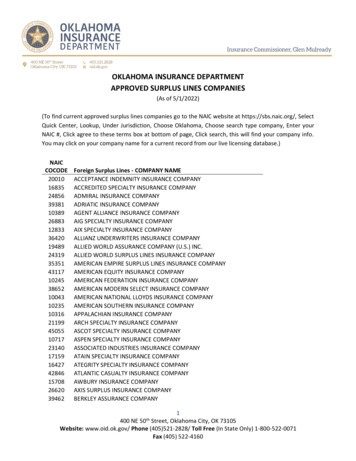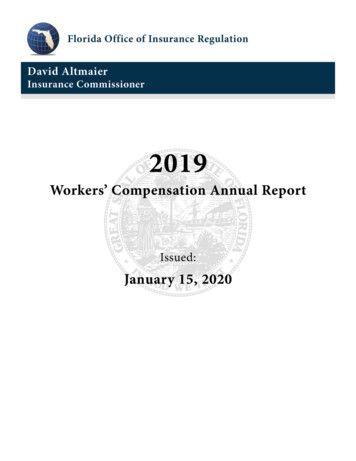
Transcription
Florida Office of Insurance Regulation, 2019 Workers’ Compensation Annual ReportJanuary 2020Page 0
Table of ContentsExecutive Summary . 2Purpose and Scope . 4Summary of the 2018 Workers’ Compensation Annual Report . 5Snapshot of the Florida Workers’ Compensation Market in 2018 . 6Ten Largest Insurers . 6Largest Insurer Groups . 7Measured Market Concentration: The Herfindahl-Hirschman Index . 9Underwriting Strength . 10Self-Insurance Funds and Other Self-Insurance . 11Comparison of the Six Major Market States. 12Dominant Firms and Competition. 13Underwriting Strength in the Most Populous States . 13Workers’ Compensation Rates . 14Cost Drivers for Workers’ Compensation . 16Physician Drug Dispensing . 17Hospital Reimbursement . 18Workers’ Compensation Court Cases . 20Comparative Rates and Premiums . 22Florida Workers’ Compensation Joint Underwriting Association. 25Florida Workers’ Compensation Insurance Guaranty Association . 28Composition of the Buyer . 29Professional Employer Organizations . 30Market Structure, Conduct and Performance to Promote Competition . 31Mandatory Rating Plans . 31Optional Plans Used by Insurers to Compete Based on Price . 32Non-Price Competition . 33Deviations . 33Large Deductibles . 34Conclusion . 35Office Certification of Compliance with Section 627.096, Florida Statutes . 37Appendix A: Florida Statutes Governing Workers’ Compensation Self-Insurance Funds NotSubject to Office Regulation . 38Florida Office of Insurance Regulation, 2019 Workers’ Compensation Annual ReportJanuary 2020Page 1
Executive SummarySubsection 627.211(6), Florida Statutes (F.S.), requires that the Office of Insurance Regulation(Office) provide an annual report to the President of the Senate and the Speaker of the House ofRepresentatives that evaluates competition in the workers’ compensation market in the state. Thepurpose of the report is to provide an analysis of the availability and affordability of workers’compensation coverage and to determine whether the current market structure, conduct andperformance are conducive to competition, based upon economic analysis and tests. The reportmust also document that the Office has complied with the provisions of section 627.096, F. S.,which requires the Office to investigate and study the data, statistics, schedules, or otherinformation as it finds necessary to assist in its review of workers’ compensation rate filings.A summary of the findings for the 2019 Workers’ Compensation Annual Report (for calendaryear 2018 data) is listed below.1. Based on a comparative analysis across a variety of economic measures, the workers’compensation market in Florida is competitive.a. A large number of independent insurers serve the workers’ compensation marketin Florida and none of the insurers has sufficient market share to exercise anymeaningful control over the price of workers’ compensation insurance.b. The Herfindahl-Hirschman Index (HHI), a measure of market concentration, —indicates the market is not overly concentrated.c. Based on the record of new entrants and withdrawals with no market disruptions,there are no significant barriers for the entry and exit of insurers into the Floridaworkers’ compensation market, which signals that the Florida workers’compensation market is well capitalized and competitive.2. Of the six most populous states, Florida is one of two in which the largest workers’compensation insurers is a private market insurer rather than a state-created residualmarket entity. This degree of private activity indicates coverage is generally available inthe voluntary market. The residual market is small, suggesting the voluntary market isabsorbing the vast majority of demand.3. Reforms to section 440.34, F.S. were a significant factor in the decline of workers’compensation insurance rates.1 It is also the case, however, that most of theimprovements resulting from these legislative changes may have been realized, as therewere four rate increases from 2010 to 2014 after seven years of decreases following the2003 reforms. Although the dramatic decreases in rates during the seven years from 20031In Murray v. Mariner Health, (Florida Supreme Court October 23, 2008) (Murray), the Florida Supreme Court held that the statute in theworkers’ compensation law did not limit attorneys’ fees under a separate subsection (3) of the law, and therefore a lawyer representing a workers’compensation claimant is entitled to a “reasonable fee.” House Bill 903 was passed into law during the 2009 Legislative Session. It restored thecap on attorney fees and clarified related statutory language determined as ambiguous by the Florida Supreme Court. As a result, workers’compensation rates decreased further.Florida Office of Insurance Regulation, 2019 Workers’ Compensation Annual ReportJanuary 2020Page 2
to 2010 were directly attributable to action taken by the Florida Legislature in 2003, thereforms have subsequently been challenged in the courts. Notably, on April 28, 2016, theFlorida Supreme Court found the statutory mandatory attorney fee schedule in section440.34, F.S., unconstitutional as a violation of due process under both the Florida andUnited States Constitutions. This ruling and other court rulings have the potential tosignificantly impact the workers’ compensation system in Florida. The initial cost impactof the Castellanos and Westphal rulings was reflected in the December 1, 2016, rateincrease. As the actual post-Castellanos & post-Westphal data emerges over time, it willbe evaluated to determine if any rate level changes are needed to ensure that rates are notexcessive, inadequate, or unfairly discriminatory.4. Medical cost drivers, particularly in the areas of drugs, hospital inpatient, and ambulatorysurgical centers (ASC) are noticeably higher in Florida than the countrywide average.Legislative reform affecting the reimbursement of these services could producesubstantial savings for Florida employers.5. Affordability within the Florida Workers’ Compensation Joint Underwriting Association,Inc. (FWCJUA), which is the residual market, has been an ongoing issue. Senate Bill 50A, enacted in 2003, and House Bill 1251, enacted in 2004, addressed affordability in thevoluntary and residual market, respectively. Over time, since the legislative changes wereenacted, affordability issues within the FWCJUA have abated. The FWCJUA averagerate differential from the voluntary market rate level has declined to the lowest level sincethe reform. It is worth noting, however, that both policy count and premium within theFWCJUA increased significantly since 2009, though it still remains a very small portionof the overall workers’ compensation market.6. The Office is in compliance with the requirements of section 627.096, F.S.Florida Office of Insurance Regulation, 2019 Workers’ Compensation Annual ReportJanuary 2020Page 3
Purpose and ScopeSection 627.211(6), Florida Statutes, mandates:“The office shall submit an annual report to the President of the Senate and the Speaker of theHouse of Representatives by January 15 of each year which evaluates competition in theworkers’ compensation insurance market in this state. The report must contain an analysis of theavailability and affordability of workers’ compensation coverage and whether the currentmarket structure, conduct, and performance are conducive to competition, based upon economicanalysis and tests. The purpose of this report is to aid the Legislature in determining whetherchanges to the workers’ compensation rating laws are warranted. The report must alsodocument that the office has complied with the provisions of s. 627.096 which require the officeto investigate and study all workers’ compensation insurers in the state and to study the data,statistics, schedules, or other information as it finds necessary to assist in its review of workers’compensation rate filings.”To meet these mandates, this report provides analysis of the following areas:1. The competitive structure of the workers’ compensation market in Florida by comparingselect key financial performance ratios, the number of insurers actively participating inthe market along with their respective market positions, and the number of insurersentering and exiting the market;2. The availability and affordability of workers’ compensation insurance in Florida. Thisincludes an analysis of rate changes in Florida’s admitted market, as well as, the ratingstructure existing in the FWCJUA and other data relative to the health and size of theFWCJUA;3. The market structure in Florida, which includes the market concentration in Floridacompared with other states, the entry and exit of insurers from the Florida market, andinsurer insolvencies;4. A comparison of pure loss costs for the 10 largest workers’ compensation class codes forFlorida compared to the other states using the National Council on CompensationInsurance (NCCI) as their statistical rating organization; and5. Documentation of the Office’s compliance with section 627.096, F.S., by investigating allworkers’ compensation carriers operating in Florida.Florida Office of Insurance Regulation, 2019 Workers’ Compensation Annual ReportJanuary 2020Page 4
Summary of the 2018 Workers’ Compensation Annual ReportIn general, the 2018 Workers’ Compensation Annual Report (for calendar year 2017 data)reached similar conclusions as the previous 14 annual reports. Specifically, this report showed: Florida’s workers’ compensation insurance market contained a large number ofindependent insurers, none of which had enough market share to individually exercisemarket control in an uncompetitive nature. The HHI indicated Florida’s market was not overly concentrated, and consequentlyexhibited a reasonable degree of competition. There were no significant barriers for insurers entering and exiting the Florida workers’compensation insurance market. The residual market was small relative to the private market indicating the voluntarymarket offers reasonable availability. Medical cost distributions showed that Florida has a higher portion of cost paid for drugs,hospital inpatient, and ambulatory surgical centers (ASC). Substantial reductions in rateswould occur if costs in Florida were brought in line with other states’ reimbursementrates. In 2017, the Florida Workers’ Compensation Insurance Guaranty Association(FWCIGA):o Handled two new insolvencies that generated 1,663 claims with an expected lossand expense claim payout of approximately 168 million;o Ended 2017 with 1,946 open claims, a significant increase over year-end 2016, whichhad 454 open claims; ando For the 12th straight year, the FWCIGA Board of Directors determined noassessment was needed to fund the cash needs for the upcoming calendar year. There may have been some small segments of the market which have difficulty obtainingworkers’ compensation insurance, including small firms and new firms.The 2018 Workers’ Compensation Annual Report also noted that the Office approved an averagerate level decrease of 13.8 percent on November 11, 2018, which became effective onJanuary 1, 2019. At the effective date, Florida’s rates at that time were 65 percent lower thanrates prior to the 2003 reforms.The 2019 Workers’ Compensation Annual Report (for calendar year 2018 data) continues toexamine the workers’ compensation insurance market and provide the HHI to compare Florida’smarket concentration to the other major workers’ compensation markets through an analysis ofkey market characteristics among the six most populous states.Additionally, the 2019 Workers’ Compensation Annual Report presents findings on the costdrivers in the Florida workers’ compensation system.Florida Office of Insurance Regulation, 2019 Workers’ Compensation Annual ReportJanuary 2020Page 5
Snapshot of the Florida Workers’ Compensation Market in 2018In 2018, 251 privately-owned insurers actively wrote workers’ compensation insurance inFlorida. In total, private sector insurers wrote 3,140,875,383 in premium. Moreover, during2018, 12 insurers entered the Florida workers’ compensation market, either as new companies orby adding the workers’ compensation line of business to their Certificate of Authority. During2018, three insurers exited the Florida market. These new entrants and voluntary withdrawalshad no disruptive impact on the marketplace.Although the relative health and competitiveness of the Florida workers’ compensation markethas been well documented following the legislative reforms implemented in 2003, several courtcases relating to workers’ compensation have together created uncertainty in the marketplace.Most of the data contained in this report does not contemplate these recent court decisions sincethe court decisions occurred in mid-2016. As the data becomes available and as analysis revealsthe impact of these cases more fully, the impact will be reflected in future reports.Ten Largest InsurersThe largest insurer, Bridgefield Employers Insurance Company, as measured by premiumwritten in the chart below, had 6.78 percent of the market in 2018, and the largest 10 insurers hada cumulative 39.92 percent of the market. This spread of premium across insurers suggests noone firm can be seen to have an overly dominant impact on the market. The 10 largest insurersby written premium are outlined in the chart below.Company NameBridgefield Employers Ins CoZenith Ins CoAssociated Industries Ins Co IncFCCI Ins CoTechnology Ins Co IncBridgefield Cas Ins CoNorguard Ins CoRetailFirst Ins CoZurich American Ins CoAmerisure Ins CoState DirectPremiumWritten 212,960,526 168,806,525 167,135,317 137,247,593 124,226,679 116,282,680 99,213,414 84,606,540 74,384,338 69,129,546MarketShare(%)CumulativeMarketShare 1517.4821.8525.8029.5032.6635.3637.7239.92Five of these insurers are domiciled in Florida with the remaining five domiciled in the eastern,mid-western and western United States. This shows the Florida workers’ compensation market isnot served exclusively by Florida-only insurers and there is some geographical diversification.Florida Office of Insurance Regulation, 2019 Workers’ Compensation Annual ReportJanuary 2020Page 6
The 10 largest insurers also display a range of diverse product lines. Some, such as BridgefieldEmployers Insurance Company and RetailFirst write all, or nearly all, of their business in theFlorida workers’ compensation market, while the others write a broader mix of workers’compensation in other states, other lines of business, or both. The table below highlights therelative size of the Florida workers’ compensation market for each of the 10 largest insurers’portfolio mix of business. This mix of business by geography and line of business adds to thestability of the Florida market.Florida Workers’Comp PremiumWritten 212,960,526Florida Workers’Comp/AllWorkers CompPremium Written(%)91.89FloridaWorkers’Comp /AllPremiumWritten (%)91.89All Workers’Comp/AllPremiumWritten (%)100Zenith Ins Co 168,806,52528.1825.1789.32Associated Industries Ins Co Inc 167,135,31710048.2348.23FCCI Ins Co 137,247,59371.1928.4039.89Technology Ins Co Inc 124,226,67914.2610.9276.57Bridgefield Cas Ins Co 116,282,68032.4232.42100Norguard Ins Co 99,213,41417.5016.0791.81%RetailFirst Ins Co 84,606,540100100100Zurich American Ins Co 74,384,3384.651.2526.80Amerisure Ins Co 69,129,54635.2017.3349.24CompanyBridgefield Employers Ins CoLargest Insurer GroupsIn 2018, the five largest insurer groups comprised 37.5 percent of the market. AmericanFinancial Group is the largest provider of workers’ compensation insurance in Florida with 11.08percent of the total market based on 2018 National Association of Insurance Commissioners(NAIC) Annual Statement data. The largest individual company in Florida, BridgefieldEmployers Insurance Company, and the 6th largest individual company in Florida, BridgefieldCasualty Insurance Company, are members of the American Financial Group. In addition, two ofthe top 10 writers of workers’ compensation insurance belong to the AmTrust NGH Group:Associated Industries Insurance Company Inc., and Technology Insurance Company Inc. Theseinsurer groups are displayed on the following page.Florida Office of Insurance Regulation, 2019 Workers’ Compensation Annual ReportJanuary 2020Page 7
Top Five Largest Workers' Compensation InsurerGroups American FinancialGroup, 11.08%AmTrust NGHGroup, 10.35%All Other Carriers,62.5%Travelers Group,5.86%Fairfax FinancialGroup, 5.59%Zurich InsuranceGroup, 4.59%Nine of the top 10 insurers found on page seven belong to one of the top 10 insurer groups inFlorida. Three of the top 10 insurer groups (Travelers Group, Hartford Fire & Casualty Group,and Chubb Insurance Group) do not have a company in the top 10 individual insurers. The top 10largest insurer groups by written premium are outlined in the chart below.Insurer Group NameAmerican Financial GroupAmTrust NGH GroupTravelers GroupFairfax Financial GroupZurich Insurance GroupHartford Fire & Casualty GroupFCCI Mutual Insurance GroupBerkshire Hathaway GroupChubb Insurance GroupRetailFirst GroupWorkers'CompensationDirect PremiumWritten 348,151,679 324,973,616 183,961,756 175,630,292 144,119,524 141,591,919 138,069,937 131,542,897 123,999,835 112,091,365Market CumulativeMarket .5158.08This spread of premium among insurer groups suggests no one group can be seen to have aprevailing impact on the market. This supports the competitive aspects of the Florida workers’compensation market.Florida Office of Insurance Regulation, 2019 Workers’ Compensation Annual ReportJanuary 2020Page 8
Measured Market Concentration: The Herfindahl-Hirschman IndexThe Herfindahl-Hirschman Index (HHI) is a widely recognized measure of market concentrationwhich can be applied to the Florida workers’ compensation market. The HHI is a calculationdesigned to determine market concentration and first appeared in A.O. Hirschman’s NationalPower and Structure of Foreign Trade published in 1945.The HHI calculation is straightforward. The measured market share of every company operatingin the identified market is squared, and the HHI for any given state is equal to the sum of thesquared market shares. The highest index value is then defined as 10,000 (100 percent squared—a monopoly), and the lowest outcome is close to zero. The U.S. Department of Justice (DOJ)uses this index when researching acquisitions and mergers for compliance with anti-trustlegislation, most notably, the Sherman Anti-Trust Act of 1890. DOJ considers a result of lessthan 1,500 to be an “unconcentrated market” or a competitive marketplace. Results of 1,500 to2,500 are considered “moderately concentrated.” Results over 2,500 are considered “highlyconcentrated,” and consequently, not very competitive.The calculated HHI for the Florida workers’ compensation insurance market in 2018 is 233.Following DOJ guidelines, this measure suggests a highly competitive market. Moreover, theHHI measure indicates the Florida workers’ compensation market has become progressivelymore competitive following the legislative reforms. As the chart below shows, the calculatedHHI of 363 in 2006 has declined to the 2018 value of 233.400350300Florida Workers' Compensation 32001501005002006 2007 2008 2009 2010 2011 2012 2013 2014 2015 2016 2017 2018Florida Office of Insurance Regulation, 2019 Workers’ Compensation Annual ReportJanuary 2020Page 9
Underwriting StrengthAn important measure of the health of an insurance market is the underwriting performance ofthe insurers in the market; that is, the combination of pricing, risk management and applicationof effective underwriting guidelines contributing to a viable and sustainable market. Twocommonly used measures are employed in this report; the loss ratio (defined as direct lossesincurred divided by direct premiums earned) and a broader measure that includes direct lossesincurred and defense cost containment expenses (DCCE) incurred as a percentage of directpremiums earned. Ratios approaching or exceeding 100 for either measure are not consideredprofitable.For the Florida workers’ compensation market in 2018, these aggregate ratios based on NAICAnnual Statement data are: Direct Loss RatioDirect plus DCCE Ratio53.29%60.63%There is natural year-to-year variation in these ratios and too much importance should not begiven to year over year changes. It is worthwhile to note that both measures are lower than theratios based on 2017 NAIC Annual Statement data (55.73% and 62.81%, respectively).In addition to the loss ratio and the loss plus DCCE ratio, another ratio commonly reviewed toevaluate underwriting performance is the combined ratio. Combined ratios are reviewed tomeasure or evaluate underwriting profitability. Combined ratios can generally be defined as thesum of losses and expenses divided by earned premium. Often dividend payments are includedas an expense item in quantifying combined ratios. According to NCCI’s presentation at its 2019State Advisory Forum, the Florida workers’ compensation combined ratio for private carriersand self-insureds has been stable for the past several years. The Accident Year combined ratiosfor Florida based on NCCI Financial Call data and NAIC Annual Statement data are as follows:Accident YearCombined Ratio2014201520162017201897%96%97%94%97%A combined ratio less than 100 percent indicates that insurers in Florida are achieving anunderwriting gain for workers’ compensation. When the combined ratio is greater than 100percent it means that insurers are paying out more in losses and expenses than they are collectingin premium. Insurers could still potentially make a profit in years where the combined ratio isgreater than 100 percent because the ratio does not include the income received frominvestments.Florida Office of Insurance Regulation, 2019 Workers’ Compensation Annual ReportJanuary 2020Page 10
Self-Insurance Funds and Other Self-InsuranceIn addition to the private market described above, which writes approximately 96 percent of theworkers’ compensation insurance in Florida, coverage is also provided through self-insurancefunds (SIFs)2.Pursuant to Florida law, certain employers may also self-insure their workers’ compensationresponsibilities and pay claims directly instead of purchasing a workers’ compensation insurancepolicy. If an employer qualifies under Florida Statutes to self-insure, the financial risk ofproviding workers’ compensation benefits to its employees is assumed by the employer directlyrather than transferring the risk to an insurance company by paying premiums to cover workers’compensation claims. If Florida’s self-insured employers paid workers’ compensation premiums,then they would comprise a significant portion of the Florida workers’ compensation market. Atthe 2019 Florida State Advisory Forum, NCCI presented data demonstrating that self-insuredemployers would make up approximately 28 percent of the total premium volume as shown inthe following table.Direct Written Premium in rriers ( )2.5372.6252.7693.1833.141SelfInsureds ( )1.0151.0201.0261.1581.192Total ( )3.5523.6453.7954.3424.333*Data obtained from NCCI State Advisory Forum on December 4, 2019;NAIC Annual Statement DataSome of the largest employers in the state of Florida are self-insured. The Florida Department ofFinancial Services, Division of Workers’ Compensation, publishes a list of active and approvedprivate self-insurers on their website3.2“Self-Insurance” groups are a broadly defined group of entities that include group self-insurance funds, commercial self-insurance funds andassessable mutual organizations. By the early 1990’s, self-insurance funds were a dominant part of the Florida workers’ compensation insurancemarket, capturing more than half of the voluntary market. Legislative reforms in 1993 transferred the regulation of group self-insurance to theDepartment of Insurance, which later became the Office of Insurance Regulation. This legislative change occurred concurrently with theformation of the FWCJUA. Together, these two changes transformed the Florida workers’ compensation insurance market as self-insurancefunds began converting into insurance companies. In 1994 there were 35 defined self-insurance funds, but by 2000 there were only four of theseentities. There were four group self-insurance funds at the start of 2010 but the largest fund, Florida Retail Federation Self Insurer’s Fundconverted to a stock company in November 2010. As a result of legislation passed in 2009, the Florida Rural Electric SIF is governed by section624.4626, F.S., which does not require the Fund to file an annual statement with OIR. Thus, the Florida Rural Electric SIF is no longer includedin this report. See Appendix A for the Florida Statutes governing SIFs not subject to OIR regulation. The remaining SIFs are the Florida Citrus,Business, & Industries Fund and the FRSA Self Insurer’s urer/ 4-1-19-Private-Self-Insurers.pdfFlorida Office of Insurance Regulation, 2019 Workers’ Compensation Annual ReportJanuary 2020Page 11
Comparison of the Six Major Market StatesFlorida is an economically and demographically diverse state. To provide meaningful context onthe Florida workers’ compensation market as described above, it is instructive to provide acomparison to similarly situated states. This section of the report focuses on the six mostpopulous states and excludes SIFs. In addition to Florida, the five most populous states used hereare California, New York, Pennsylvania, Illinois, and Texas.The table below highlights some of the key comparisons between the Florida workers’compensation insurance market and those of the other five states considered in this peer group.StateCA2018DirectPremiumWritten 12,322,820,094Rank ByDirectPremiumWritten1HHI284.47Numberof EntitiesCollectingPremiumin 4Private Insurer3.226NY 5,917,736,858FLPA 3,140,875,383 2,782,428,944TX 2,519,219,31951,941.63IL 2,466,427,020696.23234LargestProviderState FundState FundPrivate InsurerState ionRank138.1346.785.6235Based on 2018 NAIC Annual Statement Data.[1] The largest writer is Texas Mutual Insurance, an insurer created originally by the Texas Legislature in 1994. It was grantedindependence in 2001 but is still responsible for the residual market.As expected, there is a positive correlation between state population and workers’ compensationinsurance written premiums as the top six states in population rank are also in the top six forworkers’ compensation premium.In terms of the number of insurance entities writing in each market, Florida ranks fifth with 251private firms, not considering the FWCJUA or the two SIFs identified earlier. Flo
Snapshot of the Florida Workers' Compensation Market in 2018 In 2018, 251 privately-owned insurers actively wrote workers' compensation insurance in Florida. In total, private sector insurers wrote 3,140,875,383 in premium. Moreover, during 2018, 12 insurers entered the Florida workers' compensation market, either as new companies or

